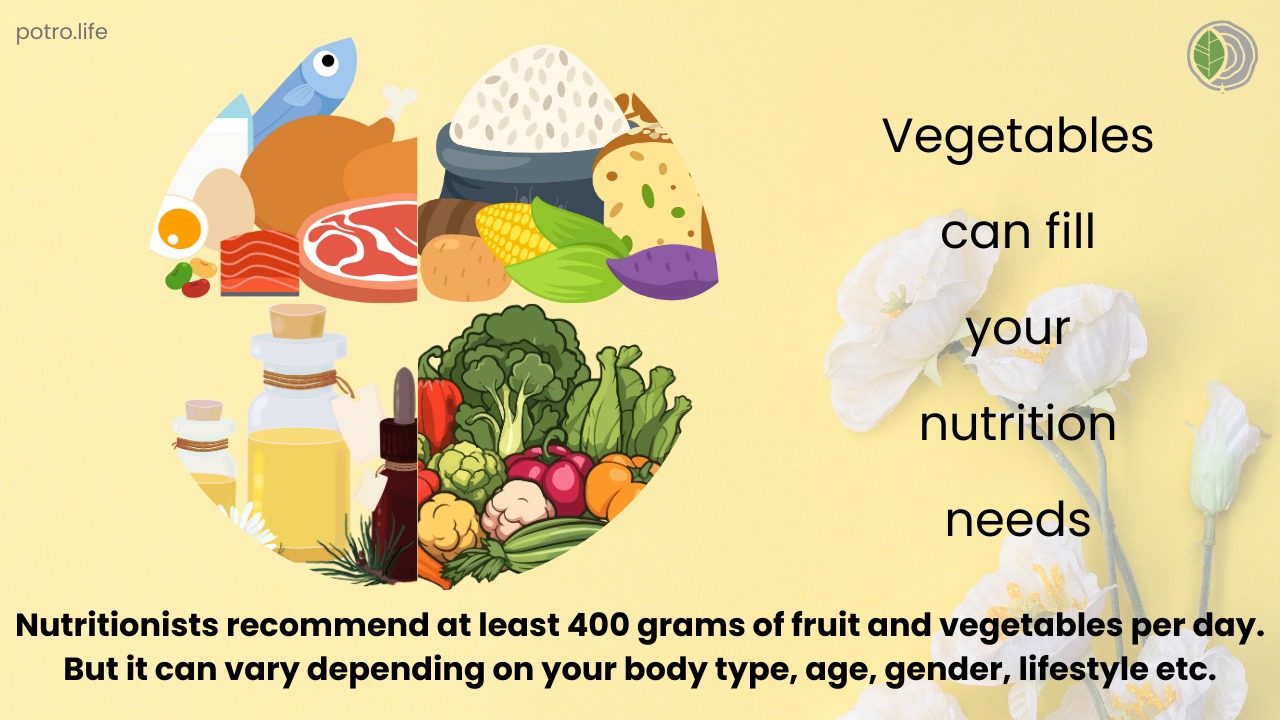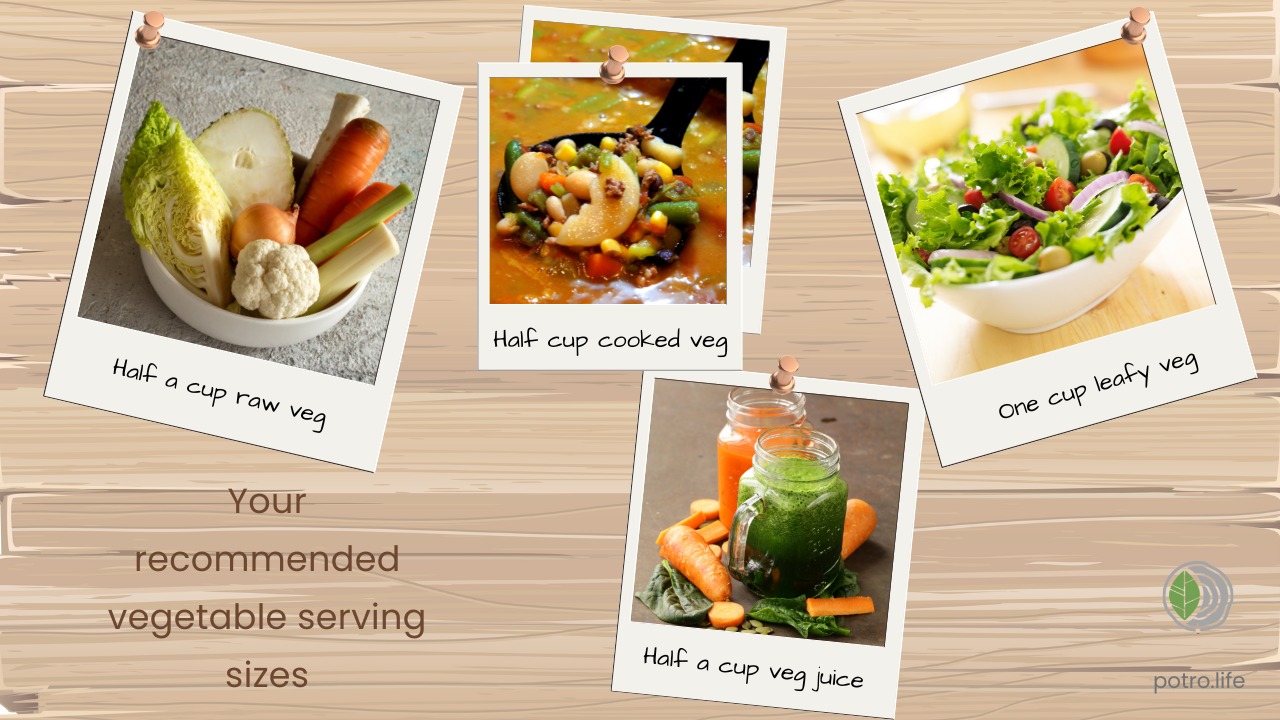Free animals in the nature do not measure their nutrition intakes and they lead a pretty healthy life. Then why do we human need to focus so much on our diet? Aren’t we supposed to eat whenever we are hungry and whatever we crave and live naturally? Well, No.
As today’s modern life makes adults live in a very different manner than the wildlife. Adults of our society have a few specific types of workhours and often less time for bodily movement or exercise. And these lifestyles have effects on our body’s nutrition requirements.
For adults, a healthy diet includes a variety of nutritious foods. Specifically, when it comes to vegetables, nutritionists recommend at least 400 grams (which is approximately five portions) of fruit and vegetables per day. Note that this recommendation excludes potatoes, sweet potatoes, cassava, and other starchy roots [1].
Key points:
- Introduction
- Serving sizes
- Vegetable and Nutrition
- Protein
- Carbohydrate
- Fiber
- Vitamin
- Antioxidants
- Fat
- References
Serving sizes
Serving sizes can vary based on the country of origin, preparation method, and measurement units used. Here are some approximate serving sizes based on different recommendations:
| Food | Measurement (Approximately) |
|---|---|
| Raw vegetables | 1/2 cup (125 ml) or 80 gm |
| Raw leafy vegetables | 1 cup (250 ml) or 80 grams |
| Cooked vegetables | 1/2 cup (125 ml) or 80 grams |
| Pure vegetable juice | 1/2 cup (125 ml) or 80 grams |
Even these recommendations are not rigid as individual nutritional needs may vary based on factors like age, gender, lifestyle, and physical activity level. It’s essential to consult with a healthcare professional or a registered dietitian to tailor the appropriate diet to one’s specific requirements.
Vegetables and nutrition
Adults should include a diverse range of vegetables to be benefitted from various nutrients. The USDA suggests the following types of food for adults to consume:
Protein
10% to 35% of calories from protein. The recommended daily protein intake varies based on factors like age, activity level, and health status [3]. On average, adults need about 8 grams of protein per kilogram of body weight [2]. The best vegetable-based protein sources are green peas, spinach, collard greens, sweet corn, Mustard greens, Lima beans, Asparagus, Broccoli, etc.
Carbohydrates
The human body needs 45% to 65% of calories from carbohydrates. Carbohydrates provide energy for daily activities. They include simple sugars (glucose, fructose) and complex carbohydrates (starch, fiber) [3]. The best carbohydrate sources are whole grains, legumes, fruits, and vegetables are excellent sources of healthy carbohydrates [2].
Fiber
The recommended daily intake of fiber varies by age and gender. On average, adults should aim for 25 to 30 grams of dietary fiber per day. [4] High-fiber vegetables to include in your diet: carrots, broccoli, beetroot, cauliflower, bitter gourd, eggplant, collard greens, swiss chard, etc.
Vitamin
Vitamins play essential roles in various bodily functions. For example, Vitamin C supports the immune system and acts as an antioxidant. Vitamin A is important for vision, skin health, and immune function. Vitamin D is vital for bone health and immune system regulation. Vitamin rich sources include fruits, vegetables, whole grains, and fortified foods.
Antioxidants
Antioxidants protect cells from oxidative damage caused by free radicals. They play a role in preventing chronic diseases and aging. Colorful fruits (berries, citrus), vegetables (spinach, kale), nuts, and seeds are rich in antioxidants. [5] [6]
Fat
An adult need 20% to 35% of calories from fat and less than 10% of total calories from saturated fat. [2] Over consumption of saturated fat can cause different type of health complication including high blood pressure and sugar, fatty liver, heart blockage etc.
Reference
[1] “Healthy diet.” Accessed: Apr. 03, 2024. [Online]. Available: https://www.who.int/news-room/fact-sheets/detail/healthy-diet
[2] “How Many Servings of Vegetables Should You Eat per Day?,” Healthline. Accessed: Apr. 03, 2024. [Online]. Available: https://www.healthline.com/nutrition/servings-of-vegetables-per-day
[3] “How to Figure Out Your Daily Macro Needs,” Verywell Fit. Accessed: Apr. 03, 2024. [Online]. Available: https://www.verywellfit.com/daily-diet-composition-calculator-charts-carbs-protein-fat-3861072
[4] A. Oliveira, F. Rodríguez-Artalejo, and C. Lopes, “The association of fruits, vegetables, antioxidant vitamins and fibre intake with high-sensitivity C-reactive protein: sex and body mass index interactions,” Eur J Clin Nutr, vol. 63, no. 11, pp. 1345–1352, Nov. 2009, doi: 10.1038/ejcn.2009.61.
[5] “Antioxidants | Free Full-Text | Food Antioxidants and Their Interaction with Human Proteins.” Accessed: Apr. 03, 2024. [Online]. Available: https://www.mdpi.com/2076-3921/12/4/815
[6] J. Kaparapu, P. M. Pragada, and M. N. R. Geddada, “Fruits and Vegetables and its Nutritional Benefits,” in Functional Foods and Nutraceuticals: Bioactive Components, Formulations and Innovations, C. Egbuna and G. Dable Tupas, Eds., Cham: Springer International Publishing, 2020, pp. 241–260. doi: 10.1007/978-3-030-42319-3_14.
“>









